Unit 7 International food
文档属性
| 名称 | Unit 7 International food |
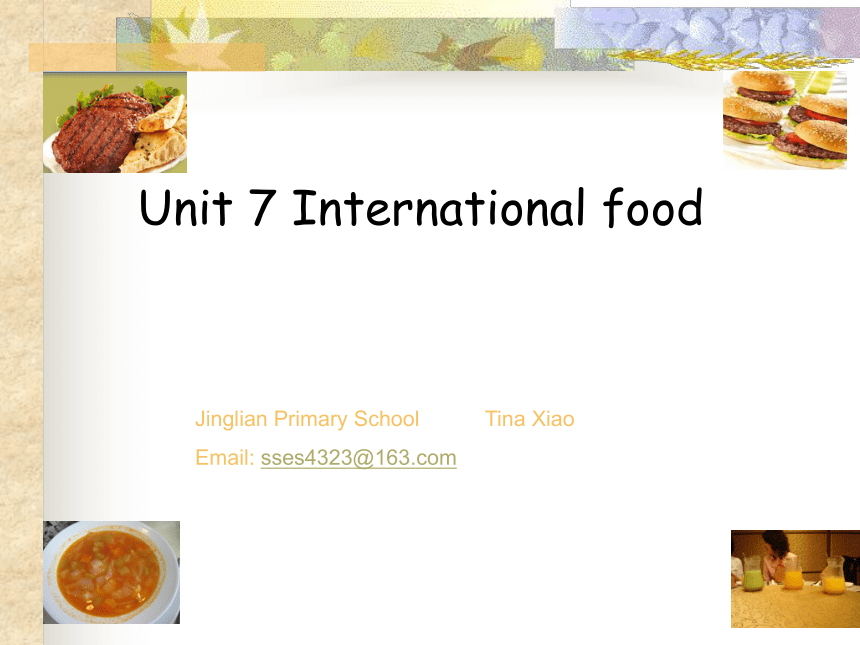
|
|
| 格式 | rar | ||
| 文件大小 | 5.8MB | ||
| 资源类型 | 教案 | ||
| 版本资源 | 深港版 | ||
| 科目 | 英语 | ||
| 更新时间 | 2009-03-30 19:24:00 | ||
图片预览

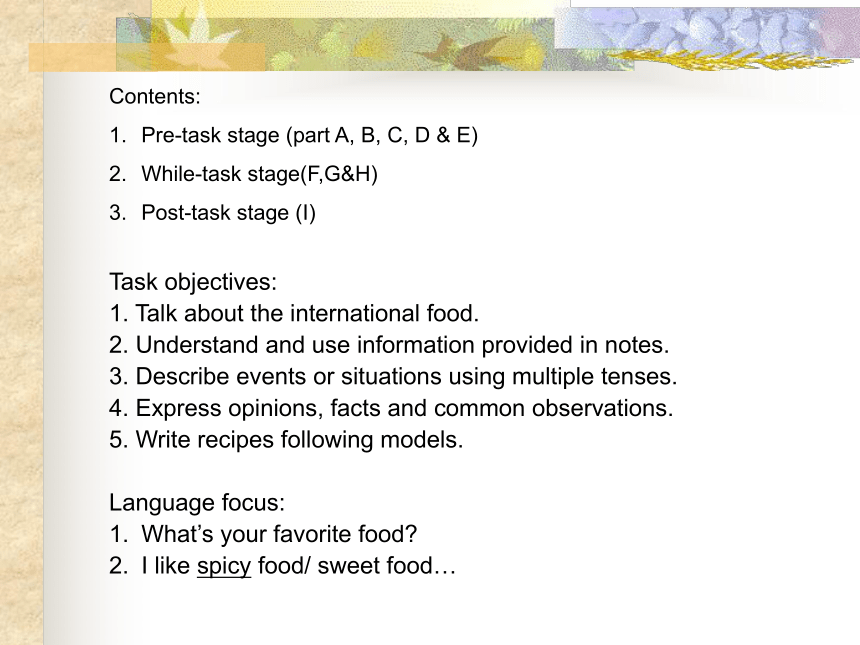
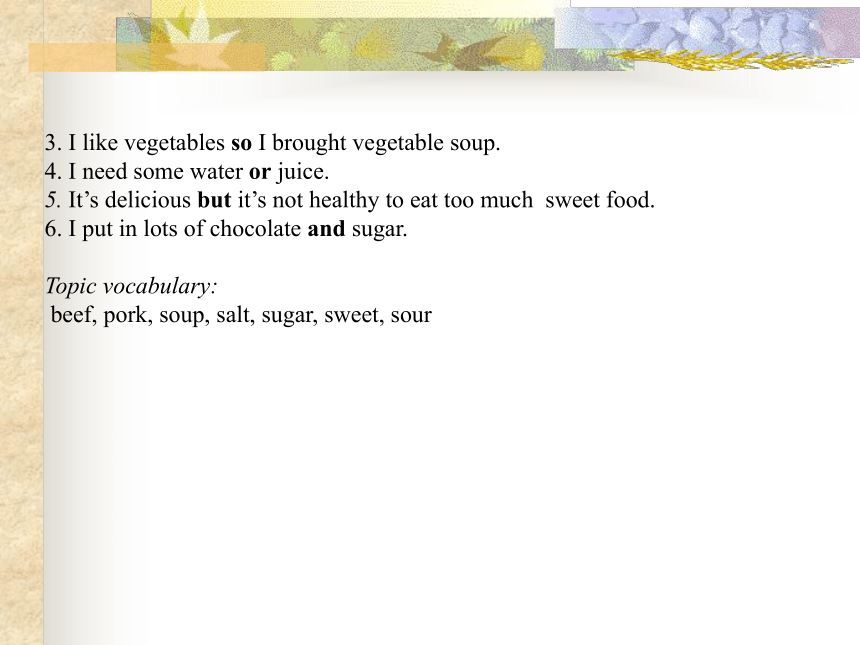

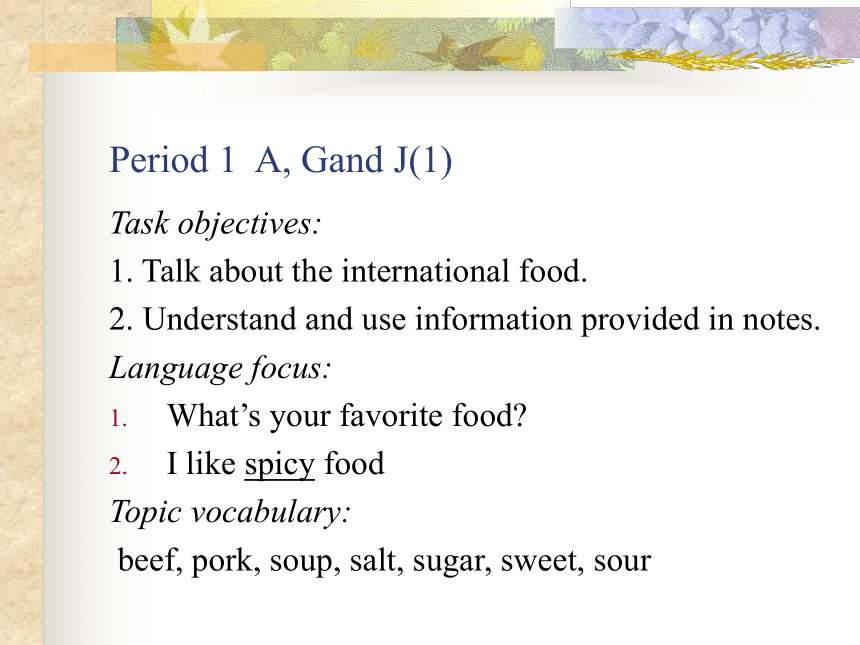
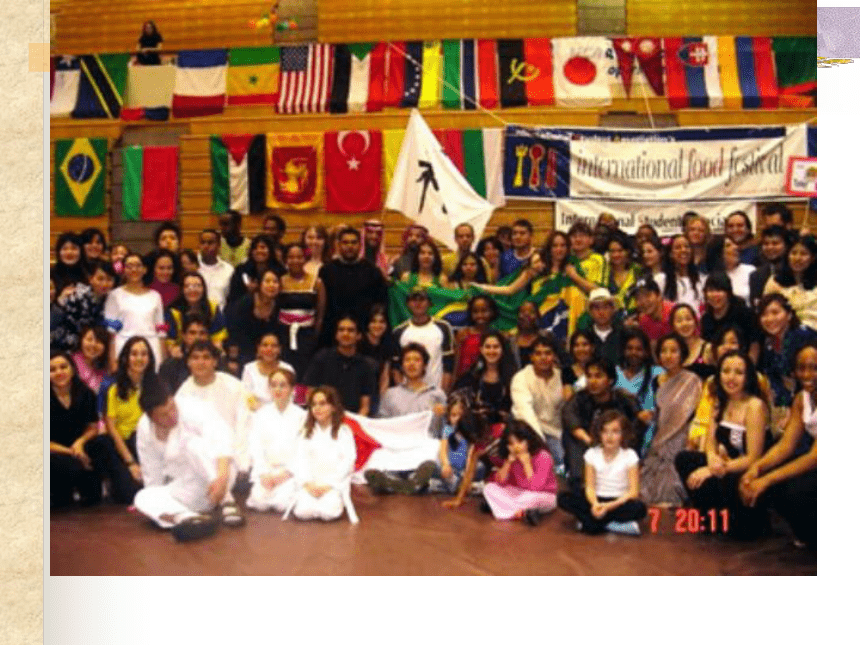
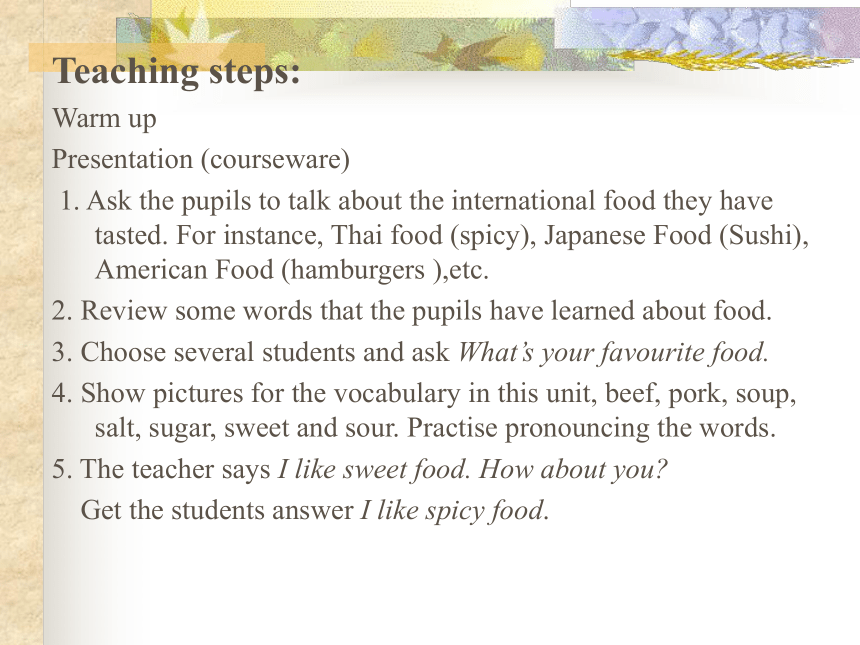
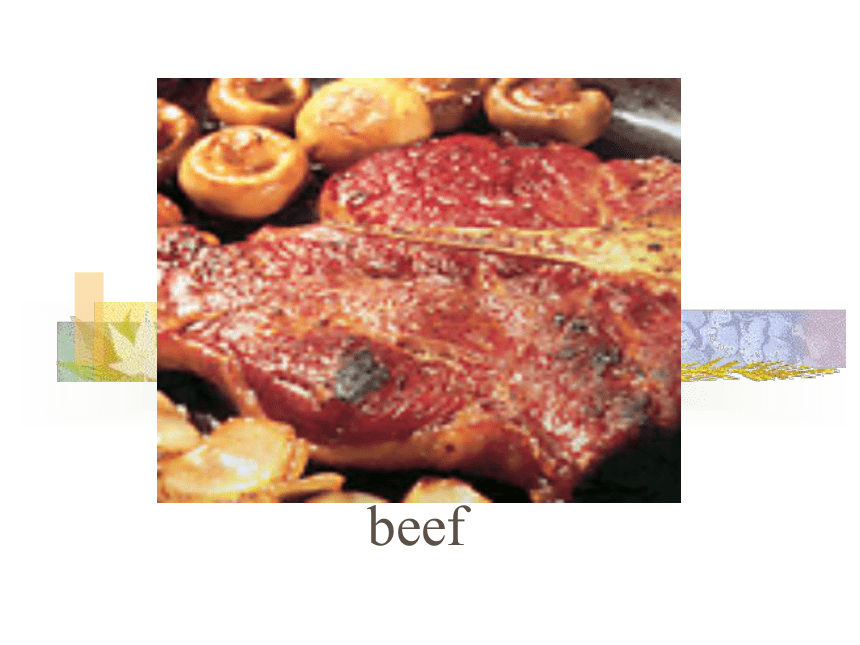
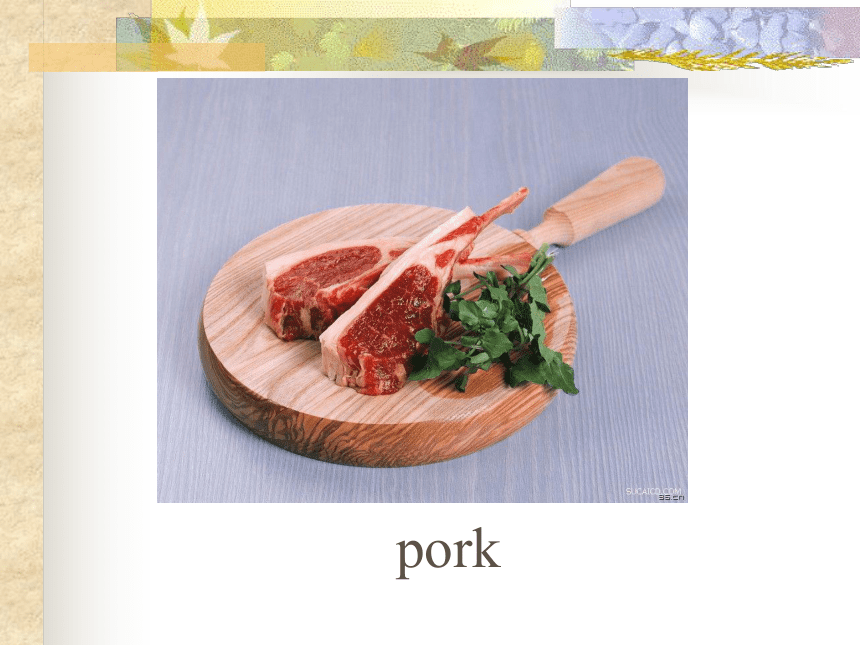
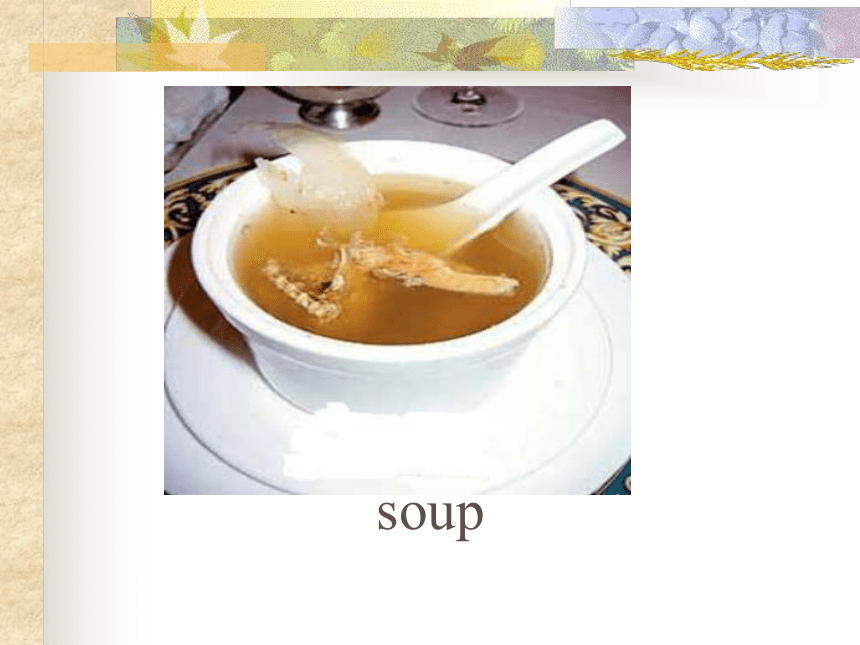

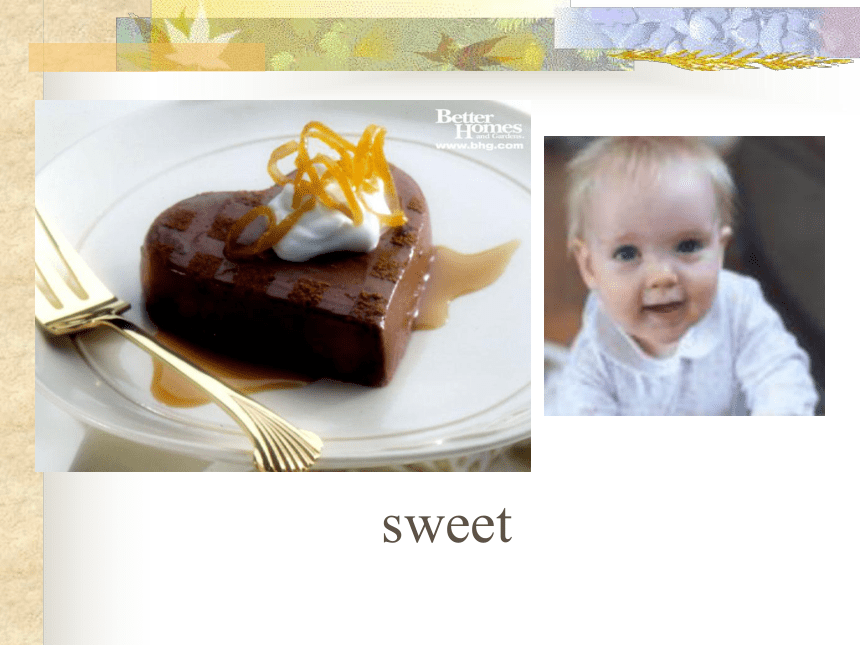
文档简介
课件76张PPT。Jinglian Primary School Tina Xiao
Email: sses4323@163.com
Unit 7 International foodContents:
Pre-task stage (part A, B, C, D & E)
While-task stage(F,G&H)
Post-task stage (I)
Task objectives:
1. Talk about the international food.
2. Understand and use information provided in notes.
3. Describe events or situations using multiple tenses.
4. Express opinions, facts and common observations.
5. Write recipes following models.
Language focus:
What’s your favorite food?
I like spicy food/ sweet food…3. I like vegetables so I brought vegetable soup. 4. I need some water or juice. 5. It’s delicious but it’s not healthy to eat too much sweet food. 6. I put in lots of chocolate and sugar. Topic vocabulary: beef, pork, soup, salt, sugar, sweet, sour 8 Periods
Period1: A ,G & J
Period2:B1 & J
Period3:B2 & B3
Period4:C&D
Period5:E, F & H
Period6:I
Period7:Revision
Period8:DO WB
Period 1 A, Gand J(1)Task objectives:
1. Talk about the international food.
2. Understand and use information provided in notes.
Language focus:
What’s your favorite food?
I like spicy food
Topic vocabulary:
beef, pork, soup, salt, sugar, sweet, sourTeaching steps:
Warm up
Presentation (courseware)
1. Ask the pupils to talk about the international food they have tasted. For instance, Thai food (spicy), Japanese Food (Sushi), American Food (hamburgers ),etc.
2. Review some words that the pupils have learned about food.
3. Choose several students and ask What’s your favourite food.
4. Show pictures for the vocabulary in this unit, beef, pork, soup, salt, sugar, sweet and sour. Practise pronouncing the words.
5. The teacher says I like sweet food. How about you?
Get the students answer I like spicy food. beef pork soup sugar sweet salt sour
Practice
1. (Book closed.) Play the Pupil’s Book Cassette. Listen once.
2. Listen again, and repeat after the tape.
3. ( Book open.) Read after the teacher.
4. Work in groups of four. Role-play the conversation between Tim and Bob and continue the conversation between Pat and Koko.
6. Pick several groups to act the dialogues.
7. Listen to the tape and chant G.
8. Do J.
Homework:
Listen to A for 5 times, read and recite it.
To collect some advertisements or articles about about restaurants in newspapers and magazines . Ask them to find some restaurants that serve good food or are famous for a certain kind of food. Bring some pictures of special food to class next period. Period2 B1Task objectives:
1. Describe events or situations using multiple tenses.
2. Express opinions, facts and common observations.
Language focus:
I like vegetables so I brought vegetable soup.
I need some water or juice.
3. It’s delicious but it’s not healthy to eat too much sweet food4.I put in lots of chocolate and sugar.
Teaching steps:
Warm-up
Listen to the tape and chant part G.
Revision
Get the pupils to talk about those restaurants in groups of four according to their homework.
Eg:
Show a picture of a restaurant and say: this is MacDonald. I like to eat the hamburgers there. It’s also famous for its’ ice creams and juice.
Presentation
Bring in four boxes. Write vegetable soup, sweet and sour pork, fried rice and juice on separate paper strips. Put one paper strip in each box.
Show the boxes to the class and say: Yesterday I went to a friend’s party and brought something to eat. Look! I brought vegetable soup; I brought sweet and sour pork and I also brought fried rice and juice. Teach them brought is the past tense of bring.
3. Teacher says: we’ll have an International Day today. What did you bring? Get them to answer: I brought…
4. Revise the conjunctions and, or, but and so with the class by asking them to finish an exercise.
Practice
Play Jinsun and ask them to listen and check the answer. Play again and get them to read part B1.
2. Ask them to finish the dialogue below partB1. Check the answer.
3. Give a situation and ask them to make a dialogue to practice the conjunctions and, or, but and so.
4. Do part J.
Homework
1. Listen, read partB1 and try to recite it fluently.
2. Write down the dialogue your group discussed in class according to the situation.
Exercise
Fill in the blanks with and, or, but and so.
A: I like vegetables _____ I brought .
B: Yum! It smells good.
A: Thanks. I made it myself.
B: I brought ______ Bob brought .
A: Bob doesn't’t like vegetables.
B: No, he doesn't ______ but he likes rice.
A: I’m thirsty. I need some ______ .
B: The juice is over there.andorbutorOral Practice
Make a dialogue in pairs according to the following situation
Your class is going to have a picnic. Each of students has to prepare a kind of food or drink. You can refer to the following things.I like… so I …I brought…and ….
Teaching objectives
Review B1 and learn B2 and B3
Teaching procedures
Step1 Revision
1. Review the words learned in part A.
2. Chant together.
3. Go over the conjunctions in part B1
Ask and answer questions about part B1, trying to make the children answer with the conjunctions like “so, but, or, and”.
Step 2 Presentation
1. Watch the video (of kingsun) about part B2. Tell the children to read the conversation and the sentences. Then they complete the sentences using the correct conjunctions.
Ask some students to read out the sentences to check the answers.
Period3: Part B2 & B3 Finish part B3
1. Before doing the listening exercise, make sure that the pupils are familiar with the words that they need to fill in the blanks. Have a dictation on the words and sentences in part A and B1.
2. Explain that Beef stew is a name of a dish.Tell the pupils that the students in B2 are going to serve a dish to join the cooking competion of the International Food Day. They need to write down their recipe and the procedures to cook.
3. Play the Pupil’s Book Cassette, and ask the pupils to write down the missing words.
4. Show one of the pupils’ answer and listen again to check it.
Step3 Practice
Tell the class that they are going to join the International Food Day, too. They are going to have a competition on cooking. Divide the class into groups of four. Each group is going to cook a dish which they all like to eat. So first they have to decide what dish they are going to make. Give them guide like this: First ask each other about the food you like or do not like, using “√”and “×”to make notes.In each group, there is one pupil to make notes in the table below.
The food we like or do not like
※We can ask each other: “ What food do you like?” “Do you like…?” to find out the answer quickly.2) Then, let’s find out, in each group, what food we four all like.
Each group should write a report about the food they like or do not like, here is a model:
Mary and I like chicken but Peter doesn't’t like it.
Both Peter and Mary like beef but I don’t like eating beef.
I want to cook _____ or ______.
Mary wants to cook _____ or ______.
We four all like ________ so we are going to cook _______.
Invite some groups to show their survey and read their report to the class.
Step 4 Homework:
A. Listen and read part A and B;
B. In groups or four, prepare a recipe of a dish that the group is going to cook.beefporksoupsaltsugarsweetsourbeef stew※We can ask each other: “ What food do you like?” “Do you like…?” to find out the answer quickly.The food we like or do not like※We can ask each other: “ What food do you like?” “Do you like…?” to find out the answer quickly.
Homework:
Listen and read part A and B;
B. In groups or four, prepare a recipe of a dish that the group is going to cook.Teaching procedures
Step1 Warm up
Everyday English
Step2 Revision
1.Show a few charts with the projector.
Step 3Presentation
1. Ask the student if they like chocolate and where chocolate comes.Tell the students that chocolate is made from cocoa. Explain that cocoa is a brown powder made from cocoa beans.
2. Pint to the picture and ask the students to describe what is in each picture.Ask the students which foods have chocolate in them. Prompt the students to give answers like cake, ice cream, biscuit, etc.
3. Let the students read the text silently at the first time.Play the Pupil’s Book Cassette for the students and ask them to say the sentences after the cassette.Period4:part C and DStep 4 Practice
Read C again .Then write T or F.
1. Ask the students to read the passage again.
2. Tell the student to read D and write T or F according to what they have read in the passage.
3. Show Transparency and check the answers with the students.
4.Ask the pupils to talk about some international food and Chinese food if time is permitted.Step 1: Talk about the pictures. Get pupils to know something about cocoa.1. Where is cocoa from?
2. What taste is it ?
3. What colour is it ?
4.When do people usually eat Chocolate?
5.What foods is it in?Step2: Read the passage and guess the meanings of the words:popular
South America,
Europe
among
be made from, be made of,EuropeSouth AmericaStep 3: Finish Part D, write T or F to the following sentences :
1. Chocolate is made from biscuits. 2. A long time ago, cocoa was not sweet. 3. People in Europe added salt to make cocoa sweet. 4. People put chocolate in ice cream, cakes and biscuits. 5. People all over the world eat chocolate.Can you talk about any other international food? Can you talk about some Chinese food?rice cakes mooncakesPeriod 5:parts E,Fand H
Objectives:
1. The students will be able to write recipes following the
models.
2. The students will be able to share their recipes of their
favorite international food.
3. Learn Part E sounds.
Teaching procedures
Step1 Warm up -Everyday English
1.Ask the pupils what kind of food they can make.
2.Part H
“Cut a tomato, an onion, a pickle and a bun and fry some ground beef. What food is this?” Show CAI of the three kinds of foods, encourage the pupils to choose the correct one.
Step2 Revision
Review PartB3 through CAI .Step 3 Part E
Step 1--- Show the sounds by ppt 2 to 5 to teach the students the sounds. Ask the students write the words on the page under each symbol. Then ask the students tell the other words with the same sounds and add them to the list.
Step 2---Check that the students are making a distinction between the sounds and the pronouncing them correctly.
Step 3--Show ppt 6 and play the Pupil’s Book Cassette to teach the students the rhyme. Then show ppt7 and play the Pupil’s Book Cassette again. Ask the students to listen to the rhyme and join in with the words or pictures of the rhyme.
Step 4—Show ppt 8 and ask the students to listen to the sounds and then write the words with the same sounds under the correct symbols.
Step 5— Point to the pictures and check that the students can say the words without any model.
Step 6—Show ppt 9 and have a review of the sounds in Unit 6 & 7
Read the symbols and say the wordsE cl [kl]gl [gl]cr [kr]gr [gr]Great!Say the rhymeLook at the clock. It’s time to go.Let’s clap for the classAnd this great food show.The crowd is in the playground
Making a happy sound.Now take your green gloves
And clean all around.Say the rhymeLook at the . It’s time to go.Let’s for the classAnd this food show.The is in the
Making a happy sound.Now take your
And all around.greatcleanListen and writeclean
clap
glovescrowdplayground
green
great
[kl][gl][kr][gr]Say the sounds and the words[pl][gr ][kr ][bl] [pr] [br] [kl] [gl]Step 4 Part F
1.Tell the students that Candy is preparing for international food day. Which is her shopping list? Listen and tick.
2.Show CAI to present parts② and ③.Look at the pictures one by one and fill in the blanks.
3.(Books open) Pupils listen to the tapescript again and finish parts①,② and ③ on Page64.
4.Pupils finish part ④ on their own first, and then talk in pairs about their choices, e.g. What did you choose? Why did you choose it?
5.Encourage the pupils to make a shopping list and write a recipe for the food the have chosen following the models from parts ① and ②.
6.Invite individuals to show their work.
7.Collect all the pupils’ recipes and put them into a class ‘ International Cookbook’ and display the book.
Step 4.HomeworkGuess: What food is it?Shopping list
2 kilos of____________
1 kilo of cabbage or_______________
some ________and __________
1 onion, 3 carrots and _________
beefleafy vegetablessaltsugartomatoesRecipe for Beef Stew
Boil the beef for______minutes.
______the cabbage or leafy vegetables.
______ the salt and sugar.
_____ the onions, carrots and tomatoes.
and ______it for another __________.20PutAddCutcook30 minutesWhich is Candy’s shopping list?Recipe for Potk and Vegetable Dumplings1 Mix some __________, leaft Vegetable and_________.Then make small circles of dough.porksalt2 Put the________,________________and salt on the dough. Close the dough around the meat.meetleaft Vegetable3 Put the _____________into a wok with hot_________.dumplingswater4 Now,it’s time to eat.Enjoy your delicious __________.dumplingsShopping listMake a shopping list and write a recipe for your food.Recipe for________HomeworkReview Part A, B and C and finish WB.
Imitate part E to make a rhyme.Period 6:part ITeaching procedures
Step1 Warm up (Part G)
Everyday English
Step2 Revision
1.What kind of food do you like?
Step 3 Presentation
1.Show Ps some key words in Part I.
2.Show Ps some pictures to learn some sentences in Part I.
3.reading skills:
a.first reading: Do you like noodles and dumplings?
b.second-reading: read through exercise below and then
begin second reading.
c.T checks the answers.
Key words:Italy 意大利
Italian 意大利(人)的
special 特别的,专门的
dough 生面团
pasta 意大利面食
ravioli 意大利馄饨
cheese 奶酪
cream 奶油,奶脂
sauce 酱汁,调味汁Questions 1. Do you like noodles and dumplings?
Yes, I like. / No, I don’t like. 2. What does Diao Xiao Mian mean?Knife-cut noodles. 3. When do Italians usually eat ravioli?
Italians usually eat ravioli for dinner.Do you like noodles
and dumplings?There are many
kinds of noodles
in China.Dao Xiao Mian –
knife-cut noodles
We cut noodle dough with a knife.
Pasta : Italy has many kinds of pasta.Italian ravioli are similar to Jaozi.
Material: dumplings, meat or cheese tomato sauce, cream sauce or cheese
True or False ? 1 Ravioli is a kind of Chinese noodle.
F 2 Jiaozi are similar to ravioli. T 3 People usually put tomato sauce on Jiaozi.F 4 Italy has many kinds of pasta.T 5 There are many kinds of noodles in China.TStep 4.Homework:.
1.Tell the students to collect menus from restaurants. Ask them to make a list of different kinds of food/drinks like spicy food, sweet food, sweet drinks,etc.
Period6:part I
Objectives: practice and improve reading skills.
Arouse Ps’interests in noodles and dumplings of China and Italy..
New words and phrases:
????????? Italy 意大利
????????? Italian 意大利(人)的
????????? special 特别的,专门的
????????? dough 生面团
????????? pasta 意大利面食
????????? ravioli 意大利馄饨
????????? cheese 奶酪
????????? cream 奶油,奶脂
????????? sauce 酱汁,调味汁
?Teaching procedures
Step1 Warm up (Part G)
Everyday English
Step2 Revision
1. What kind food do you like?
Step 3Presentation
?????????? 1. Show Ps some key words in Part I.
2. Show Ps some pictures to learn some sentences in Part I.
3..reading-skills.
a.??? first reading: 3 WH Qs and find out key words.
1 . Do you like noodles and dumplings?
2. What does Diao Xiao Mian mean?3. When do Italians usually eat ravioli?
b.??? second-reading : read through exercise below and then begin the second reading.
4. Check the answer.Ask them to rewrite the false sentences into correct sentences.
Step 4 :Homework
1. Tell the students to collect menus from restaurants. Ask them to make a list of different kinds of food/drinks like spicy food, sweet food, sweet drinks,etc.
2. Surf the internet to learn
Thanks !
Email: sses4323@163.com
Unit 7 International foodContents:
Pre-task stage (part A, B, C, D & E)
While-task stage(F,G&H)
Post-task stage (I)
Task objectives:
1. Talk about the international food.
2. Understand and use information provided in notes.
3. Describe events or situations using multiple tenses.
4. Express opinions, facts and common observations.
5. Write recipes following models.
Language focus:
What’s your favorite food?
I like spicy food/ sweet food…3. I like vegetables so I brought vegetable soup. 4. I need some water or juice. 5. It’s delicious but it’s not healthy to eat too much sweet food. 6. I put in lots of chocolate and sugar. Topic vocabulary: beef, pork, soup, salt, sugar, sweet, sour 8 Periods
Period1: A ,G & J
Period2:B1 & J
Period3:B2 & B3
Period4:C&D
Period5:E, F & H
Period6:I
Period7:Revision
Period8:DO WB
Period 1 A, Gand J(1)Task objectives:
1. Talk about the international food.
2. Understand and use information provided in notes.
Language focus:
What’s your favorite food?
I like spicy food
Topic vocabulary:
beef, pork, soup, salt, sugar, sweet, sourTeaching steps:
Warm up
Presentation (courseware)
1. Ask the pupils to talk about the international food they have tasted. For instance, Thai food (spicy), Japanese Food (Sushi), American Food (hamburgers ),etc.
2. Review some words that the pupils have learned about food.
3. Choose several students and ask What’s your favourite food.
4. Show pictures for the vocabulary in this unit, beef, pork, soup, salt, sugar, sweet and sour. Practise pronouncing the words.
5. The teacher says I like sweet food. How about you?
Get the students answer I like spicy food. beef pork soup sugar sweet salt sour
Practice
1. (Book closed.) Play the Pupil’s Book Cassette. Listen once.
2. Listen again, and repeat after the tape.
3. ( Book open.) Read after the teacher.
4. Work in groups of four. Role-play the conversation between Tim and Bob and continue the conversation between Pat and Koko.
6. Pick several groups to act the dialogues.
7. Listen to the tape and chant G.
8. Do J.
Homework:
Listen to A for 5 times, read and recite it.
To collect some advertisements or articles about about restaurants in newspapers and magazines . Ask them to find some restaurants that serve good food or are famous for a certain kind of food. Bring some pictures of special food to class next period. Period2 B1Task objectives:
1. Describe events or situations using multiple tenses.
2. Express opinions, facts and common observations.
Language focus:
I like vegetables so I brought vegetable soup.
I need some water or juice.
3. It’s delicious but it’s not healthy to eat too much sweet food4.I put in lots of chocolate and sugar.
Teaching steps:
Warm-up
Listen to the tape and chant part G.
Revision
Get the pupils to talk about those restaurants in groups of four according to their homework.
Eg:
Show a picture of a restaurant and say: this is MacDonald. I like to eat the hamburgers there. It’s also famous for its’ ice creams and juice.
Presentation
Bring in four boxes. Write vegetable soup, sweet and sour pork, fried rice and juice on separate paper strips. Put one paper strip in each box.
Show the boxes to the class and say: Yesterday I went to a friend’s party and brought something to eat. Look! I brought vegetable soup; I brought sweet and sour pork and I also brought fried rice and juice. Teach them brought is the past tense of bring.
3. Teacher says: we’ll have an International Day today. What did you bring? Get them to answer: I brought…
4. Revise the conjunctions and, or, but and so with the class by asking them to finish an exercise.
Practice
Play Jinsun and ask them to listen and check the answer. Play again and get them to read part B1.
2. Ask them to finish the dialogue below partB1. Check the answer.
3. Give a situation and ask them to make a dialogue to practice the conjunctions and, or, but and so.
4. Do part J.
Homework
1. Listen, read partB1 and try to recite it fluently.
2. Write down the dialogue your group discussed in class according to the situation.
Exercise
Fill in the blanks with and, or, but and so.
A: I like vegetables _____ I brought .
B: Yum! It smells good.
A: Thanks. I made it myself.
B: I brought ______ Bob brought .
A: Bob doesn't’t like vegetables.
B: No, he doesn't ______ but he likes rice.
A: I’m thirsty. I need some ______ .
B: The juice is over there.andorbutorOral Practice
Make a dialogue in pairs according to the following situation
Your class is going to have a picnic. Each of students has to prepare a kind of food or drink. You can refer to the following things.I like… so I …I brought…and ….
Teaching objectives
Review B1 and learn B2 and B3
Teaching procedures
Step1 Revision
1. Review the words learned in part A.
2. Chant together.
3. Go over the conjunctions in part B1
Ask and answer questions about part B1, trying to make the children answer with the conjunctions like “so, but, or, and”.
Step 2 Presentation
1. Watch the video (of kingsun) about part B2. Tell the children to read the conversation and the sentences. Then they complete the sentences using the correct conjunctions.
Ask some students to read out the sentences to check the answers.
Period3: Part B2 & B3 Finish part B3
1. Before doing the listening exercise, make sure that the pupils are familiar with the words that they need to fill in the blanks. Have a dictation on the words and sentences in part A and B1.
2. Explain that Beef stew is a name of a dish.Tell the pupils that the students in B2 are going to serve a dish to join the cooking competion of the International Food Day. They need to write down their recipe and the procedures to cook.
3. Play the Pupil’s Book Cassette, and ask the pupils to write down the missing words.
4. Show one of the pupils’ answer and listen again to check it.
Step3 Practice
Tell the class that they are going to join the International Food Day, too. They are going to have a competition on cooking. Divide the class into groups of four. Each group is going to cook a dish which they all like to eat. So first they have to decide what dish they are going to make. Give them guide like this: First ask each other about the food you like or do not like, using “√”and “×”to make notes.In each group, there is one pupil to make notes in the table below.
The food we like or do not like
※We can ask each other: “ What food do you like?” “Do you like…?” to find out the answer quickly.2) Then, let’s find out, in each group, what food we four all like.
Each group should write a report about the food they like or do not like, here is a model:
Mary and I like chicken but Peter doesn't’t like it.
Both Peter and Mary like beef but I don’t like eating beef.
I want to cook _____ or ______.
Mary wants to cook _____ or ______.
We four all like ________ so we are going to cook _______.
Invite some groups to show their survey and read their report to the class.
Step 4 Homework:
A. Listen and read part A and B;
B. In groups or four, prepare a recipe of a dish that the group is going to cook.beefporksoupsaltsugarsweetsourbeef stew※We can ask each other: “ What food do you like?” “Do you like…?” to find out the answer quickly.The food we like or do not like※We can ask each other: “ What food do you like?” “Do you like…?” to find out the answer quickly.
Homework:
Listen and read part A and B;
B. In groups or four, prepare a recipe of a dish that the group is going to cook.Teaching procedures
Step1 Warm up
Everyday English
Step2 Revision
1.Show a few charts with the projector.
Step 3Presentation
1. Ask the student if they like chocolate and where chocolate comes.Tell the students that chocolate is made from cocoa. Explain that cocoa is a brown powder made from cocoa beans.
2. Pint to the picture and ask the students to describe what is in each picture.Ask the students which foods have chocolate in them. Prompt the students to give answers like cake, ice cream, biscuit, etc.
3. Let the students read the text silently at the first time.Play the Pupil’s Book Cassette for the students and ask them to say the sentences after the cassette.Period4:part C and DStep 4 Practice
Read C again .Then write T or F.
1. Ask the students to read the passage again.
2. Tell the student to read D and write T or F according to what they have read in the passage.
3. Show Transparency and check the answers with the students.
4.Ask the pupils to talk about some international food and Chinese food if time is permitted.Step 1: Talk about the pictures. Get pupils to know something about cocoa.1. Where is cocoa from?
2. What taste is it ?
3. What colour is it ?
4.When do people usually eat Chocolate?
5.What foods is it in?Step2: Read the passage and guess the meanings of the words:popular
South America,
Europe
among
be made from, be made of,EuropeSouth AmericaStep 3: Finish Part D, write T or F to the following sentences :
1. Chocolate is made from biscuits. 2. A long time ago, cocoa was not sweet. 3. People in Europe added salt to make cocoa sweet. 4. People put chocolate in ice cream, cakes and biscuits. 5. People all over the world eat chocolate.Can you talk about any other international food? Can you talk about some Chinese food?rice cakes mooncakesPeriod 5:parts E,Fand H
Objectives:
1. The students will be able to write recipes following the
models.
2. The students will be able to share their recipes of their
favorite international food.
3. Learn Part E sounds.
Teaching procedures
Step1 Warm up -Everyday English
1.Ask the pupils what kind of food they can make.
2.Part H
“Cut a tomato, an onion, a pickle and a bun and fry some ground beef. What food is this?” Show CAI of the three kinds of foods, encourage the pupils to choose the correct one.
Step2 Revision
Review PartB3 through CAI .Step 3 Part E
Step 1--- Show the sounds by ppt 2 to 5 to teach the students the sounds. Ask the students write the words on the page under each symbol. Then ask the students tell the other words with the same sounds and add them to the list.
Step 2---Check that the students are making a distinction between the sounds and the pronouncing them correctly.
Step 3--Show ppt 6 and play the Pupil’s Book Cassette to teach the students the rhyme. Then show ppt7 and play the Pupil’s Book Cassette again. Ask the students to listen to the rhyme and join in with the words or pictures of the rhyme.
Step 4—Show ppt 8 and ask the students to listen to the sounds and then write the words with the same sounds under the correct symbols.
Step 5— Point to the pictures and check that the students can say the words without any model.
Step 6—Show ppt 9 and have a review of the sounds in Unit 6 & 7
Read the symbols and say the wordsE cl [kl]gl [gl]cr [kr]gr [gr]Great!Say the rhymeLook at the clock. It’s time to go.Let’s clap for the classAnd this great food show.The crowd is in the playground
Making a happy sound.Now take your green gloves
And clean all around.Say the rhymeLook at the . It’s time to go.Let’s for the classAnd this food show.The is in the
Making a happy sound.Now take your
And all around.greatcleanListen and writeclean
clap
glovescrowdplayground
green
great
[kl][gl][kr][gr]Say the sounds and the words[pl][gr ][kr ][bl] [pr] [br] [kl] [gl]Step 4 Part F
1.Tell the students that Candy is preparing for international food day. Which is her shopping list? Listen and tick.
2.Show CAI to present parts② and ③.Look at the pictures one by one and fill in the blanks.
3.(Books open) Pupils listen to the tapescript again and finish parts①,② and ③ on Page64.
4.Pupils finish part ④ on their own first, and then talk in pairs about their choices, e.g. What did you choose? Why did you choose it?
5.Encourage the pupils to make a shopping list and write a recipe for the food the have chosen following the models from parts ① and ②.
6.Invite individuals to show their work.
7.Collect all the pupils’ recipes and put them into a class ‘ International Cookbook’ and display the book.
Step 4.HomeworkGuess: What food is it?Shopping list
2 kilos of____________
1 kilo of cabbage or_______________
some ________and __________
1 onion, 3 carrots and _________
beefleafy vegetablessaltsugartomatoesRecipe for Beef Stew
Boil the beef for______minutes.
______the cabbage or leafy vegetables.
______ the salt and sugar.
_____ the onions, carrots and tomatoes.
and ______it for another __________.20PutAddCutcook30 minutesWhich is Candy’s shopping list?Recipe for Potk and Vegetable Dumplings1 Mix some __________, leaft Vegetable and_________.Then make small circles of dough.porksalt2 Put the________,________________and salt on the dough. Close the dough around the meat.meetleaft Vegetable3 Put the _____________into a wok with hot_________.dumplingswater4 Now,it’s time to eat.Enjoy your delicious __________.dumplingsShopping listMake a shopping list and write a recipe for your food.Recipe for________HomeworkReview Part A, B and C and finish WB.
Imitate part E to make a rhyme.Period 6:part ITeaching procedures
Step1 Warm up (Part G)
Everyday English
Step2 Revision
1.What kind of food do you like?
Step 3 Presentation
1.Show Ps some key words in Part I.
2.Show Ps some pictures to learn some sentences in Part I.
3.reading skills:
a.first reading: Do you like noodles and dumplings?
b.second-reading: read through exercise below and then
begin second reading.
c.T checks the answers.
Key words:Italy 意大利
Italian 意大利(人)的
special 特别的,专门的
dough 生面团
pasta 意大利面食
ravioli 意大利馄饨
cheese 奶酪
cream 奶油,奶脂
sauce 酱汁,调味汁Questions 1. Do you like noodles and dumplings?
Yes, I like. / No, I don’t like. 2. What does Diao Xiao Mian mean?Knife-cut noodles. 3. When do Italians usually eat ravioli?
Italians usually eat ravioli for dinner.Do you like noodles
and dumplings?There are many
kinds of noodles
in China.Dao Xiao Mian –
knife-cut noodles
We cut noodle dough with a knife.
Pasta : Italy has many kinds of pasta.Italian ravioli are similar to Jaozi.
Material: dumplings, meat or cheese tomato sauce, cream sauce or cheese
True or False ? 1 Ravioli is a kind of Chinese noodle.
F 2 Jiaozi are similar to ravioli. T 3 People usually put tomato sauce on Jiaozi.F 4 Italy has many kinds of pasta.T 5 There are many kinds of noodles in China.TStep 4.Homework:.
1.Tell the students to collect menus from restaurants. Ask them to make a list of different kinds of food/drinks like spicy food, sweet food, sweet drinks,etc.
Period6:part I
Objectives: practice and improve reading skills.
Arouse Ps’interests in noodles and dumplings of China and Italy..
New words and phrases:
????????? Italy 意大利
????????? Italian 意大利(人)的
????????? special 特别的,专门的
????????? dough 生面团
????????? pasta 意大利面食
????????? ravioli 意大利馄饨
????????? cheese 奶酪
????????? cream 奶油,奶脂
????????? sauce 酱汁,调味汁
?Teaching procedures
Step1 Warm up (Part G)
Everyday English
Step2 Revision
1. What kind food do you like?
Step 3Presentation
?????????? 1. Show Ps some key words in Part I.
2. Show Ps some pictures to learn some sentences in Part I.
3..reading-skills.
a.??? first reading: 3 WH Qs and find out key words.
1 . Do you like noodles and dumplings?
2. What does Diao Xiao Mian mean?3. When do Italians usually eat ravioli?
b.??? second-reading : read through exercise below and then begin the second reading.
4. Check the answer.Ask them to rewrite the false sentences into correct sentences.
Step 4 :Homework
1. Tell the students to collect menus from restaurants. Ask them to make a list of different kinds of food/drinks like spicy food, sweet food, sweet drinks,etc.
2. Surf the internet to learn
Thanks !
